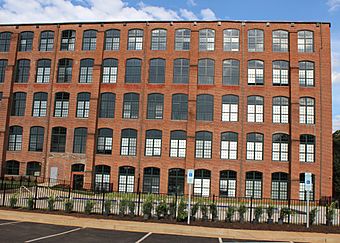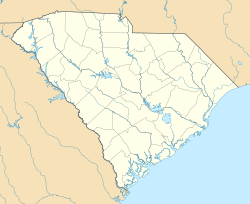Brandon Mill facts for kids
Quick facts for kids |
|
|
Brandon Mill (Restored and Converted to The West Village Lofts at Brandon Mill)
|
|

Brandon Mill was converted to lofts, 2019.
|
|
| Location | 25 Draper Street, Greenville County, South Carolina |
|---|---|
| NRHP reference No. | 14000317 |
| Added to NRHP | September 3, 2014 |
The Brandon Mill, now known as the West Village Lofts, is a historic textile mill building. It is located just west of Greenville, in Greenville County, South Carolina. This mill was built in the early 1900s. It is a great example of the many mills in the "Textile Crescent" area. These mills were very important for the economy of South Carolina's upstate region back then. The building was added to the National Register of Historic Places in 2014. Today, the main mill building has been turned into cool loft apartments.
Contents
The Story of Brandon Mill
How Brandon Mill Was Built
The idea for Brandon Mill came about in 1899. A man named J. Irving Westervelt planned it. The famous company Lockwood, Greene & Company from Providence, Rhode Island designed the building. A local builder, Jacob W. Cagle, constructed it. The mill was finished in January 1901. It was named Brandon, possibly after a textile-making village near Belfast.
A Growing Community
Many workers for the mill came from the Appalachian region and other rural areas. In just five years, the mill grew a lot! It went from 16,000 to 86,000 spindles (parts of machines that spin thread). The number of workers also jumped from 150 to 420. The mill village, where workers lived, grew from 66 to 420 homes. By 1918, the company even had its own school, church, nursery, and a community center. This center had a dining room, library, showers, and a nurse's station.
Baseball and Mill Life
Baseball was a very popular sport for mill employees in the early 1900s. Mill owners even competed to get the best players. They hoped this would make employees proud and keep them busy in a good way. One of the most famous players from a mill team was Shoeless Joe Jackson. He started his baseball career at Brandon Mill. Later, he became one of professional baseball's greatest hitters.
Challenges and Changes
Brandon Mill faced money problems by 1913. August W. Smith became its new president. In 1919, a company from New York took control. However, the local managers stayed in charge. In the 1920s, the mill got much bigger. This expansion was led by Joseph E. Sirrine, a very important engineer in the area.
Even before the Great Depression started, the textile industry was struggling. To make more products, mill owners asked workers to manage more machines. This was called the "stretch-out." In March 1929, 1,200 workers at Brandon Mill went on strike. They stopped working to protest. Owners and workers reached an agreement in May. But the textile business continued to get worse.
To keep the mill open in the 1930s, August Smith cut work hours and pay. He did this instead of firing people. This strategy made workers very loyal to the mill. During the general textile strike of 1934, workers at Brandon Mill reportedly stood up to strike organizers. They wanted to keep working.
War and Decline
During World War II, Brandon Mill did very well. It received government orders for special fabrics. These included "duck cloth," medical gauze, and uniform twill fabric. In December 1946, Abney Mills bought Brandon Corporation. They started selling the mill village houses.
Textile mills were still doing well in the 1950s and 60s. But then, many textile companies started offshoring. This means they moved their factories to other countries. Labor costs were cheaper in those places. Brandon Mill reduced its number of workers in 1969. Finally, the mill closed its doors in 1977.
New Life for the Mill
The main building was first sold to be a warehouse. Then, in 2001, it was bought by Focus Golf. They used it as a distribution center for Dunlop Sport. In 2014, a real estate developer named Pace Burt bought the property. He turned the main building into loft apartments. To help with taxes, Burt applied for the building to be on the National Register. It was approved in September. In 2015, Burt gave one building in the complex to the Greenville Center for Creative Arts. The new loft apartments opened for people to live in during 2016.



